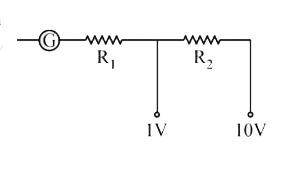When 500μA curre nt is passed through a galvanometer of 20Ω , it gives a full scale deflection. The external resistance need to be connected to measure 5V is
98Ω parallel
9980Ω parallel
98Ω series
9980Ω series
The correct Answer is:D
To solve the problem, we need to find the external resistance that should be connected in series with a galvanometer to measure a voltage of 5V when a current of 500μA is flowing through it. The resistance of the galvanometer is given as 20Ω.
1. Identify the given values:
- Current through the galvanometer, Ig=500μA=500×10−6A
- Resistance of the galvanometer, G=20Ω
- Voltage to be measured, V=5V
2. Use Ohm's Law to find the total resistance:
The total voltage across the circuit can be expressed using Ohm's Law:
V=Ig×(R+G)
where R is the external resistance we need to find.
3. Rearranging the equation:
We can rearrange the equation to solve for R:
R+G=VIg
Thus,
R=VIg−G
4. Substituting the values:
Now, substituting the known values into the equation:
R=5V500×10−6A−20Ω
5. Calculating 5500×10−6:
5500×10−6=50.0005=10000Ω
6. Finding R:
Now, substituting this back into the equation for R:
R=10000Ω−20Ω=9980Ω
7. Conclusion:
The external resistance that needs to be connected in series to measure 5V is:
R=9980Ω
Final Answer:
The external resistance needed is 9980 Ω in series.
---
- Current through the galvanometer, Ig=500μA=500×10−6A
- Resistance of the galvanometer, G=20Ω
- Voltage to be measured, V=5V
The total voltage across the circuit can be expressed using Ohm's Law:
V=Ig×(R+G)
where R is the external resistance we need to find.
We can rearrange the equation to solve for R:
R+G=VIg
Thus,
R=VIg−G
Now, substituting the known values into the equation:
R=5V500×10−6A−20Ω
5500×10−6=50.0005=10000Ω
Now, substituting this back into the equation for R:
R=10000Ω−20Ω=9980Ω
The external resistance that needs to be connected in series to measure 5V is:
R=9980Ω
The external resistance needed is 9980 Ω in series.
Topper's Solved these Questions
- BOOK - AAKASH SERIESCHAPTER - MOVING CHARGES AND MAGNETISMEXERCISE - EXERCISE-III49videos
MOVING CHARGES AND MAGNETISM
- BOOK - AAKASH SERIESCHAPTER - MOVING CHARGES AND MAGNETISMEXERCISE - EXERCISE-IB71videos
MOVING CHARGES AND MAGNETISM
- BOOK - AAKASH SERIESCHAPTER - MOTION IN A STRAIGHT LINE EXERCISE - very Short answer type question15videos
MOTION IN A STRAIGHT LINE
- BOOK - AAKASH SERIESCHAPTER - NUCLEAR PHYSICSEXERCISE - ADDITIONAL PRACTICE PRACTICE SHEET (ADVANCED) Integer Type Questions3videos
NUCLEAR PHYSICS
Similar Questions
When a current of 5mA is passed through a galvanometer having a coil of resistance 15Ω, it shows full sacle deflection. The value of the resistance to be put in series with the galvanometer to convert it into a voltmeter of range 0−10V is:
View SolutionWhen 0.005A current flows through a moving coil galvanometer, it gives fullscale deflection. It is converted into a voltmeter to read 5 Volt, using an external resistance of 975Ω. The resistance of galvanometer in ohms is
View Solution
Knowledge Check
- Question 1 - Select One
The resistance of a galvanometer is 10Ω. It gives full-scale deflections when 1mA current is passed. The resistance connected in series for converting it into a voltmeter of 2.5V will be
A24.9ΩB249ΩC2490ΩD24900Ω
The resistance of a galvanometer is 10Ω. It gives full-scale deflections when 1mA current is passed. The resistance connected in series for converting it into a voltmeter of 2.5V will be
View SolutionA galvanometer has a resistance of 30 ohm and a current of 2 mA is needed to give a full scale deflection. What is the resistance needed and how is it to be connected to convert this galvanometer
(a) Into an ammeter of 0.3 A range ?
(b) Into a volmeter of 0.2 V range ?View SolutionThe resistance of a moving coil galvanometer is 20Ω. It requires 0.01 A current for full - scale deflection. The value of resistance to convert it into a voltmeter of the range 20 V will be
View SolutionWhen 2 amperes current is passed through a tangent galvanometer, it gives a deflection of 30∘. For 60∘ deflection, the current must be
View SolutionA maximum current of 0.5 mA can be passed through a galvanometer of resistance 20Ω. Calculate the resistance to be connected in series to convert it into a voltmeter of range (0−5)V.
View SolutionA galvenometer has a resistance of 30Ω, and a current of 2mA is needed for a full- scale deflection. What is the resistance and how is it to be connected to converted to the voltmeter of 0−2V range?
View SolutionThe resisitance of a galvanometer is 50Ω and it shows full scale diflection for current of 1 mA. . To convert it into a voltmeter to measure 1V and as well as 10 V ( refer circuit diagram ) the resistance R1 and R2 respecivtively
 View Solution
View Solution

